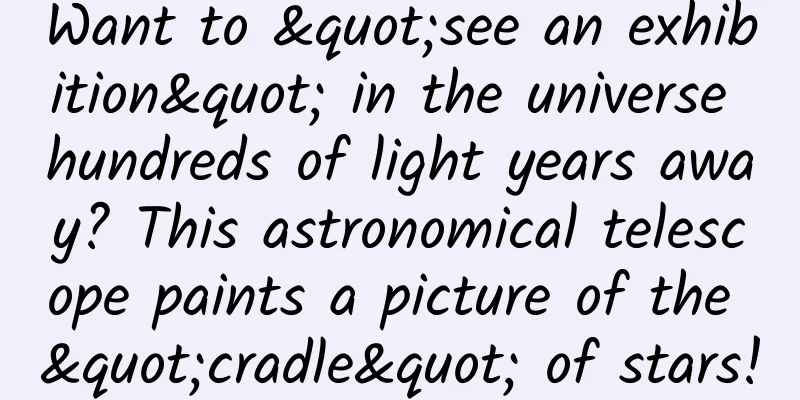Want to "see an exhibition" in the universe hundreds of light years away? This astronomical telescope paints a picture of the "cradle" of stars!

|
In recent years, more and more people have begun to take the route of "elegant New Year", and "Spring Festival exhibitions" and "artistic New Year" have become a new trend. For example, during the 2023 Spring Festival, many Shanghai citizens and tourists visited the "Jade Rabbit Elf" special exhibition held at the Shanghai Museum to welcome the Spring Festival of the Year of the Rabbit. The 2024 Spring Festival is getting closer and closer. Do you know that there is a magnificent nebula "art exhibition" in the distant space hundreds of light years away from the universe? Who has such a great ability to take us to see such an "art exhibition"? It is the famous "James Webb Space Telescope". 01 Hubble's successor: James Webb Space Telescope The James Webb Space Telescope (JWST, hereinafter referred to as the Webb Telescope) is a collaboration between NASA, the European Space Agency (ESA) and the Canadian Space Agency (CSA). As the successor to the Hubble Space Telescope, it is currently the most complex and expensive astronomical telescope in the world; it carries four scientific instruments: the Near Infrared Camera (NIRCam), the Near Infrared Spectrometer (NIRSpec), the Mid-Infrared Instrument (MIRI), the Fine Guidance Sensor/Near Infrared Imager and the Seamless Spectrometer (FGS/NIRISS) . As can be seen from the names of these instruments, unlike the Hubble Telescope, the Webb Telescope mainly observes the infrared band (see Figure 1), which has a wavelength greater than the visible light band seen by the human eye . Its main tasks include searching for the first generation of galaxies formed after the Big Bang, studying the evolution of galaxies, observing the birth process of stars and planetary systems, and measuring the chemical composition of solar system planets and exoplanets to explore the possibility of their existence of life . Figure 1. Observation bands of the Hubble and Webb space telescopes (Image source: Webb space telescope media kit/NASA) The powerful primary mirror (6.5-meter aperture) of the Webb telescope can provide unprecedented resolution and sensitivity, and people are looking forward to it presenting us with a clearer and more magnificent picture of the universe. In July 2022, the first scientific images of the Webb telescope were released, including a nebula filled with gas and dust, the Carina Nebula (Figure 2, upper right), which was considered by many netizens to be the most beautiful of the first scientific images. The author used it as the desktop wallpaper of his computer. In July 2023, to commemorate the first anniversary of scientific operation, the Webb telescope released a stunning nebula image, the Rho Ophiuchi cloud (Figure 3), which looks like an impressionist painting and was selected by Nature magazine as one of the top ten scientific images of 2023. The Webb telescope is like Monet in space, showing the beauty of light and shadow of the universe vividly. Figure 2. The first scientific images released by the Webb telescope. Upper left: The Southern Ring Nebula in two infrared bands; Upper right: A corner of the Carina Nebula (NGC 3324); Lower left: Stephan's Quintet galaxies; Lower right: Galaxy cluster SMACS 0723. (Image courtesy of NASA, ESA, CSA, and STScI) Figure 3. A corner of the Ophiuchus Nebula captured by the Webb telescope. The dazzling hexagonal starburst of each star is caused by the construction of the Webb telescope's primary and secondary mirrors. (Image courtesy of NASA, ESA, CSA, STScI, Klaus Pontoppidan (STScI), Alyssa Pagan (STScI)) 02 Magnificent Nebula: The Cradle of Star Birth The Carina Nebula and the Ophiuchi Nebula photographed by the Webb telescope are both star-forming regions, that is, where stars are born. Observing these areas is one of the core scientific goals of the Webb telescope, and it is expected to reveal the mystery of star birth . Among them, the Ophiuchi Nebula is the closest star-forming region to us, about 390 light-years away. Astronomers believe that a huge molecular cloud will collapse into thousands or even millions of stars. These molecular clouds are star-forming regions. They are mainly composed of about 70% hydrogen, 28% helium, and a small amount of other elements . The typical scale of molecular clouds is tens of light years to hundreds of light years, with a mass of tens of thousands to millions of solar masses and a very low temperature of about minus 250 degrees Celsius. These molecular clouds are not a uniform whole, and there are many complex structures inside. The collapse of molecular clouds requires gravitational instability, which, together with turbulence, rotation and magnetic fields, determines the spatial and mass distribution of molecular cloud clumps, which are the regions where stars and star clusters are formed. Many clumps or sub-clumps of molecular clouds collapse together, so stars are born in groups , like brothers and sisters in a large family, and then spread out over time. Astronomers estimate that our sun has several thousand brothers and sisters . The collapse of the molecular cloud clusters gradually increases the temperature at the center, forming an object called a protostar. This protostar has not yet started nuclear fusion because the core temperature is not high enough to sustain nuclear reactions. The protostar will rely on gravity to accrete the surrounding gas to form an accretion disk (see Figure 4). As the mass of the protostar continues to increase, the temperature and pressure inside gradually increase, eventually reaching a level sufficient to start nuclear fusion and become a star . The greater the mass, the shorter the time required for this process. For a star with the mass of the sun, it takes about 50 million years, which is a very short infant period compared to the 10 billion-year lifespan of the sun . When the protostar accretion ends or is about to end, the remaining gas and dust on the accretion disk will collide and gather to form a core, accreting the surrounding gas and dust, and eventually forming a planet around the star. Figure 4. Twenty different protostars and their accretion disks. (Image from ALMA (ESO/NAOJ/NRAO), S. Andrews et al.; NRAO/AUI/NSF, S. Dagnello) Over the past few decades, astronomers have gradually understood how interstellar gas clouds collapse into stars and their surrounding planets, but there are still many unclear details and unresolved questions. The answers to these questions may reveal the origin of the solar system and even the origin of life. Therefore, the Webb telescope has made observing the star formation process one of its core scientific goals. 03How was the colorful stellar cradle photographed? Star-forming regions are filled with dust, which blocks light (imagine smog), making it impossible for us to see the details inside the star-forming regions and the stars being born. Infrared light can penetrate the dust, which is exactly the observation band of the Webb telescope . Therefore, compared to the Hubble telescope, the Webb telescope can see more clearly (see celestial bodies blocked by dust) in addition to clearer details (higher resolution ). Figure 5 On the left is the famous "Pillars of Creation" (a small part of the Eagle Nebula) photographed by Hubble. These dark brown pillars that seem to be gushing out are dust. The picture on the right is the same area photographed by the Webb telescope. It can be seen that Webb's photos are obviously more transparent, and many areas and stars blocked by dust are revealed in Hubble's photos. Figure 5. A portion of the Eagle Nebula as captured by the Hubble (left) and Webb (right) telescopes. (Image courtesy of NASA, ESA, CSA, STScI; Joseph DePasquale (STScI), Anton M. Koekemoer (STScI), Alyssa Pagan (STScI).) Our human eyes cannot see infrared light, so why can we see so many colorful photos taken by Webb? In fact , all the colors we see in daily life can be synthesized with several basic colors . For example, various display devices and digital cameras use the three primary colors of red, green and blue to synthesize other colors; printers use cyan, red and yellow to synthesize various color pictures. The colors in astronomical observations actually correspond to a very narrow band. You can see a color by observing with one band . For example, you can see a red world with a red lens, which is equivalent to only red light passing through the lens. This kind of lens is called a filter in astronomy. For the Ophiuchus Nebula observed by Webb (Figure 3), it was photographed using a near-infrared camera . A total of five filters were used to take the photos separately, and then each photo was assigned a color visible to the human eye. Finally, the colorful nebula we see was synthesized, including: Filter F187N (center wavelength 1.874 μm) specified as blue Filter F200W (1.990 μm) is light blue Filter F335W (3.365 microns) is cyan Filter F444W (4.421 μm) is yellow Filter F470N (4.707 microns) is red As the wavelength of the filters increases, the wavelength of the specified color also increases . There are about 50 newly born stars in the Ophiuchus Nebula region photographed in Figure 3, most of which are similar in size to our sun. Our solar system may have been born in such a nebula 4.5 billion years ago . There is a bright star in the center of the structure like a stalactite cave in the lower left. This is the only star in this area that is much larger than the sun. This young star can't suppress its inner enthusiasm and releases blazing light and stellar wind, like a carving knife, carving the wall (dust) of the nebula, slowly eroding it, forming what we see. This cavity is also filled with a light blue mist-like gas - polycyclic aromatic hydrocarbons (PAHs), which is a class of hydrocarbon organic compounds that are very common in the interstellar medium. Its radiation characteristics are around 3.3 microns. The red stalagmite-like structure in the upper right is a newly born star that broke through the outer envelope and produced jets in two opposite directions, just like a newborn baby stretching its arms for the first time. The red is the radiation from molecular hydrogen, because it has radiation characteristics around 4.693 microns. There is a dark area in the center that is roughly triangular in shape, indicating that the thick dust has blocked even infrared light. The vast universe not only feasts our eyes with its magnificence, but also allows us to gain true knowledge through its hidden mysteries. Constantly exploring the universe is exploring ourselves, and always respecting the universe is respecting ourselves! References: https://www.nature.com/immersive/d41586-023-03872-z/index.html https://webbtelescope.org/news/webb-science-writers-guide/science-with-webb https://webbtelescope.org/contents/news-releases/2023/news-2023-128 Author: Yan Zhen, researcher at Shanghai Astronomical Observatory, Chinese Academy of Sciences Produced by: Science Popularization China Produced by: China Science and Technology Press Co., Ltd., China Science and Technology Publishing House (Beijing) Digital Media Co., Ltd. |
Recommend
Lei Jun's three-hour talk: I don't have time to worry
[[134230]] Every once in a while, this star entre...
Chen Wen's top private equity trading skills secret training camp: call auction + time-sharing decision-making
Chen Wen's top private equity trading skills ...
Was it "drunk" so much that it stopped production? Why is this pesticide still being used despite repeated bans?
Audit expert: Wu Xinsheng Deputy Chief Physician,...
Youku video advertising account opening process and billing details
Youku is an advertising platform with many differ...
Alchemy has gone from legend to reality? How long can the "nobleness" of natural gold last?
At the beginning of 2024, the exchange of special...
How to save the disordered biological clock in the "reversed day and night" holiday life?
Planning: Li Peiyuan Editor: Dong Xiaoxian Review...
The Origin of Qixi Festival Story Summary Qixi Festival Cowherd and Weaver Girl Story Summary
The Qixi Festival, a festival for begging for cle...
4 strategies + 7 tips, a comprehensive interpretation of Xiaohongshu promotion strategy!
If you ask me which platform users enjoy watching...
It took him 8 years to finally publish his paper in Science, proving that mice have human-like imagination!
The brain of mice is only the size of our thumb t...
Analyze the user life cycle and improve app engagement
When your app has acquired a certain number of us...
How to take demand analysis to the extreme?
Once you have a good product idea and have determ...
From 0 to 1, how can technology products identify the right seed users?
This is a boiling era. In the past month, Apple, ...
What should an online education live broadcast room look like?
Affected by the epidemic in the first half of 202...
Tonga volcano erupts, but the spewing of hot magma could cause global temperatures to drop?
Recently, the Hunga Tonga volcano (20.5°S, 175.4°...
How to find operational and promotional strategies that can be combined in the World Cup?
The World Cup has begun, and it's time for fa...









